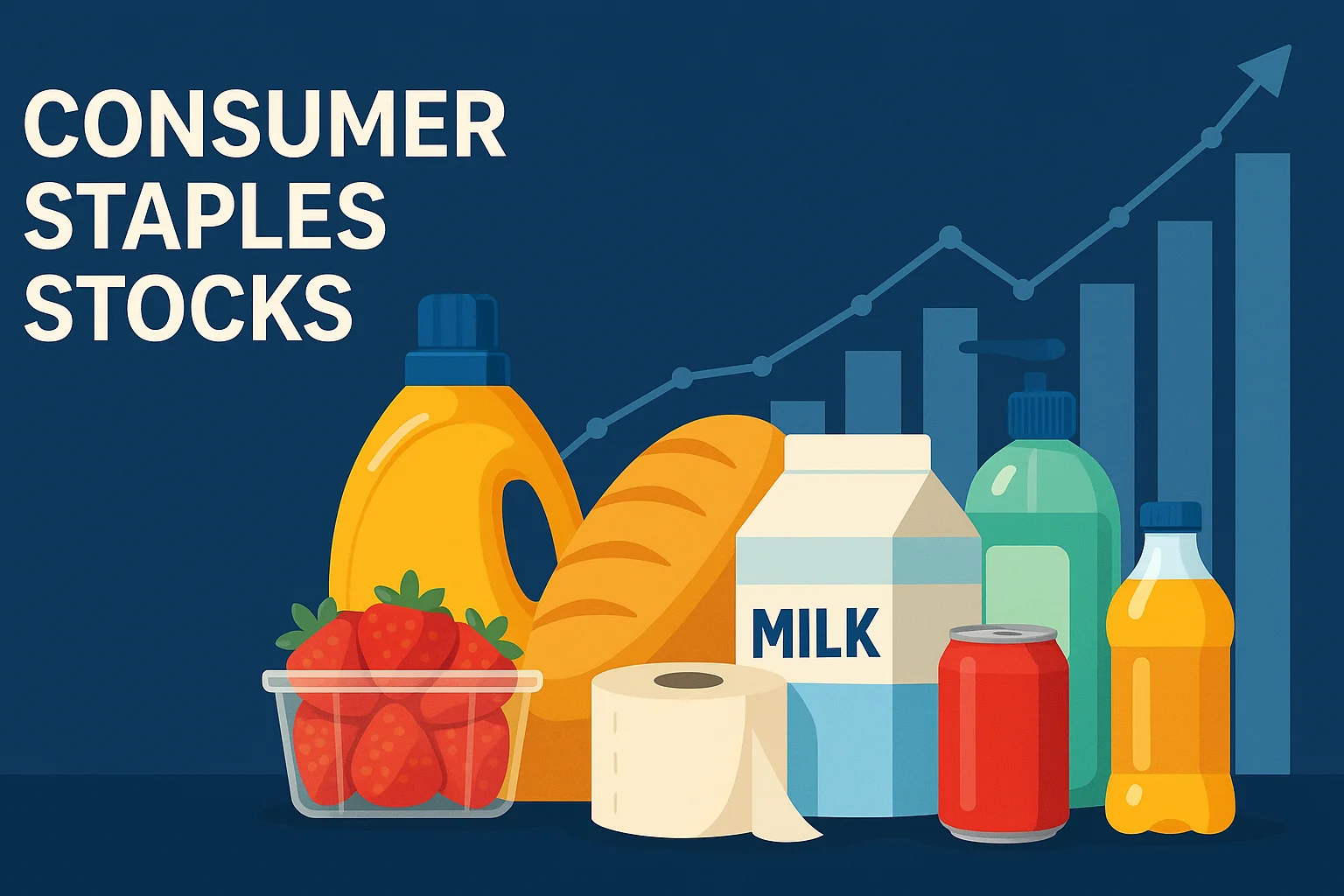Introduction
Every investor, whether conservative or aggressive, seeks balance, reliability, and long-term growth in their portfolio. That’s where consumer staples come in. Often underestimated, these essential goods and services offer unmatched consistency and stability across market conditions.
From groceries and hygiene products to household cleaners and beverages, consumer staples are things people buy regardless of economic climate. That consistent demand makes them a core holding in any intelligent portfolio strategy.
In this article, we explore why consumer staples are considered foundational to long-term investing success, how they perform during market downturns, their dividend potential, and how they play a vital role in hedging risk.
What Are Consumer Staples?
Consumer staples include products and services people need for daily living. Unlike discretionary items such as luxury clothing or travel, staples cover basic needs that remain constant regardless of the economy.
Examples of consumer staples include:
- Food and beverage products
- Household cleaning supplies
- Personal hygiene items
- Over-the-counter medicines
- Baby care and feminine hygiene products
- Alcohol and tobacco (in some classifications)
These items are often sold by some of the world’s most well-known and stable companies, including Procter & Gamble, Coca-Cola, PepsiCo, Unilever, and Colgate-Palmolive.
Recession-Proof Nature
Why Staples Shine in Economic Downturns
When markets fall and recession hits, many sectors suffer sharp losses. Consumers cut spending, delay purchases, and adjust their budgets. However, they don’t stop brushing their teeth, washing clothes, or buying groceries. That’s why consumer staples companies tend to remain profitable even in tough times.
Historical data shows that during past recessions, consumer staples stocks consistently outperformed the broader market. Their revenues may not spike dramatically, but their resilience keeps portfolios afloat when other holdings sink.
Past Crisis Performance
For example, during the 2008 financial crisis:
- The S&P 500 dropped over 37%
- The Consumer Staples Select Sector SPDR Fund (XLP) dropped only about 15% and recovered more quickly
This makes them a defensive asset class that can cushion the blow of market corrections.
Consistent Dividend Income
One of the biggest reasons investors flock to consumer staples is the reliable stream of dividends they offer.
Many of these companies are Dividend Aristocrats, meaning they’ve raised dividends every year for 25+ years. Their business models generate predictable cash flow, allowing them to return capital to shareholders regardless of market conditions.
Examples include:
- Procter & Gamble (PG) – Over 60 years of consecutive dividend increases
- Coca-Cola (KO) – Among the most famous dividend-paying stocks globally
- Kimberly-Clark (KMB) – Steady income with brand reliability
Dividend-paying consumer staples are especially attractive to retirees, income-focused investors, and risk-averse individuals.
Lower Volatility and Long-Term Security
A Buffer Against Portfolio Swings
Consumer staples tend to be low-beta stocks, meaning they move less aggressively than the overall market. In turbulent times, this reduced volatility acts as a shock absorber for portfolios, minimizing wild price fluctuations.
For long-term investors, especially those nearing retirement or with lower risk tolerance, this consistency brings peace of mind. Instead of chasing high-growth stocks that may soar or collapse, staples offer measured, steady returns over time.
Reliable Earnings
Because their products are always in demand, consumer staples companies often beat earnings expectations—even in weak quarters for other sectors. Their forecastable revenue streams allow for stable planning and fewer surprises.
Hedge Against Inflation
Inflation can hurt consumers and investors alike, but consumer staples offer a unique advantage: pricing power.
These companies can often pass higher input costs onto consumers without losing business, thanks to brand loyalty and necessity. When prices rise across the economy, staples providers like grocery brands or toothpaste manufacturers don’t face the same pushback that non-essential products might.
This helps protect profit margins and makes consumer staples a natural inflation hedge within a diversified investment strategy.
Global Demand and Growth Potential
Emerging Markets and Middle-Class Expansion
Many consumer staples giants operate globally. In developing countries, rising income levels mean more people are gaining access to branded food, drinks, and household products.
This creates a huge growth opportunity for these companies. As populations expand and urbanize, demand for reliable, high-quality staple goods increases.
Innovation in the Sector
Consumer staples companies are not stagnant. They evolve through:
- Product innovation (healthier food, eco-friendly packaging)
- Technology adoption (supply chain automation, AI in forecasting)
- E-commerce strategies (direct-to-consumer sales, subscriptions)
So while their revenue may grow slower than tech startups, their adaptability ensures long-term viability.
Ideal for All Investor Types
For Beginners
Consumer staples offer an excellent entry point. Their business models are easy to understand, and their stocks are often less volatile, making them ideal for new investors looking to learn the ropes.
For Conservative Investors
Those seeking capital preservation find solace in the defensive nature of these stocks. Consumer staples act like anchors in rough seas, ensuring portfolios don’t drift too far off course during market storms.
For Growth and Dividend Investors
Dividend reinvestment and modest price appreciation over time create a powerful combination. Long-term investors can benefit from compound growth, particularly when dividends are reinvested through DRIPs (Dividend Reinvestment Plans).
Real-World Examples of Portfolio Impact
Case 1: Pandemic Resilience
During the COVID-19 pandemic, consumer staples stocks remained among the least affected. Panic buying boosted revenues, and online grocery orders surged. Stocks like Clorox and General Mills saw record highs due to demand for cleaning and pantry products.
Case 2: 2022 Inflation Spike
When inflation peaked in 2022, many sectors saw shrinking margins. Meanwhile, companies like Nestlé and PepsiCo managed to raise prices with minimal volume decline. Their stocks provided investors with a cushion while tech and growth sectors tumbled.
How Much of Your Portfolio Should Be in Staples?
While there’s no one-size-fits-all answer, most financial advisors suggest allocating 10% to 20% of your equity portfolio to consumer staples—depending on your risk appetite and time horizon.
In defensive or income-focused strategies, this allocation can go even higher.
Choosing the Right Staples Stocks
Look for companies with:
- Strong brand recognition
- Global reach
- Reliable dividend history
- Recession-tested business models
- Low debt and consistent earnings
To simplify your stock selection process, platforms like 5starsstocks.com/staples offer curated lists of top-performing consumer staples stocks that combine growth potential with risk mitigation.
Conclusion
Consumer staples may not be flashy, but they are the quiet strength behind every resilient investment portfolio. They offer unmatched consistency, reliable dividends, and defense against economic shocks.
Whether you’re just starting out or managing a multi-million-dollar portfolio, adding the right consumer staples stocks ensures balance, protection, and peace of mind. And in a market where uncertainty is the only constant, that kind of reliability is priceless.


